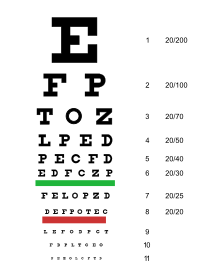B2 (classification)
B2 is a group to allow athletes with different vision to compete against each other in sports.
Definition[change | change source]


B2 is a group to allow athletes with different vision to compete against each other in sports.[1] The International Blind Sports Association (IBSA) says B2 athletes are: "From ability to recognise the shape of a hand to a visual acuity of 2/60 and/or visual field of less than 5 degrees."[2] The Canadian Paralympic Committee says B2 athletes havve "Up to approximately 3-5% functional vision."[3] B2 is used in other sports than sports run by the IBSA. Other sports using B2 are blind golf. Blind golf rules say B2 golfers include "From ability to recognise the shape of a hand up to visual acuity of 2/60 or visual field of less than 5 degrees".[4]
B2 is equal to other disability classifications for other sports. In adaptive rowing, the similar B2 class is LTA-B2.[5] In horse riding, Grade 4 is the similar group to B2.[6][7] For swimming, the similar disability group for B2 is S12.[8]
History[change | change source]
B2 has its history in the early history of blind sports. When blind people first started competing, people believed people who had better vision could unfairly compete against people with worse vision. Different groups around vision problem were developed by the IBSA to make playing sport more fair for people with different levels of blindness.[9]
The IBSA B2 is mostly the same since it was created,[10] even as the International Paralympic Committee (IPC) changed methods to allow people to fairly compete against each other based on functional ability.[11][12]
Equipment[change | change source]
Equipment used by B2 sportspeople may include sighted guides, guide rails, beeping balls and clap sticks.[13] The use of a sighted guide by B2 athletes depends on the sport.[14] For blind archery, B2 sportspeople use a sighting device based on the sense of touch and must not be able to see well enough to use a bowsight.[15]
References[change | change source]
- ↑ "A-Z of Paralympic classification". BBC Sport. 4 June 2003. Retrieved 11 June 2012.
- ↑ "IBSA Medical Classification". International Blind Sports Association. Archived from the original on 11 August 2011. Retrieved 3 October 2012.
- ↑ "Winter Sport Classification". Canadian Paralympic Committee. 2012. Archived from the original on 20 October 2012. Retrieved 3 October 2012.
- ↑ Australian Sports Commission; Australian Confederation of Sports for the Disabled (1990). The development of a policy : Integration Conference 1990 Adelaide, December 3-5, 1990. Willoughby, N.S.W.: Australian Confederation of Sports for the Disabled. OCLC 221061502.
- ↑ "Rowing Australia: Adaptive Rowing Classification Application Form" (PDF). Australia: Rowing Australia. 2012. Archived from the original (PDF) on 15 April 2014. Retrieved 19 June 2012.
- ↑ "Equestrian". New South Wales, Australia: Australian Paralympic Committee. 2012. Retrieved 18 June 2012.
- ↑ "Equestrian". Paralympics Great Britain. 2012. Retrieved 14 April 2013.
- ↑ Yves Vanlandewijck; Walter Thompson (13 July 2011). Handbook of Sports Medicine and Science, The Paralympic Athlete. John Wiley & Sons. ISBN 978-1-4443-4828-6. Retrieved 14 April 2013.
- ↑ Donald F. C. Loran; Caroline J. MacEwen (1995). Sports Vision. Butterworth-Heinemann. p. 45. ISBN 978-0-7506-1578-5. Retrieved 14 April 2013.
- ↑ "Sight Classification Form". United Kingdom: British Blind Sport. 2009. Archived from the original on 9 March 2016. Retrieved 14 April 2013.
- ↑ "Classification History". Bonn, Germany: International Paralympic Committee. Retrieved 30 July 2012.
- ↑ "Paralympic Classification Today". International Paralympic Committee. 22 April 2010. p. 3.
{{cite web}}: Missing or empty|url=(help) - ↑ Marc R. Safran; Douglas B. McKeag; Steven P. Van Camp (1998). Sports Medicine. Lippincott Williams & Wilkins. p. 197. ISBN 978-0-7817-1222-4. Retrieved 14 April 2013.
- ↑ Gregory S. Kolt; Lynn Snyder-Mackler (2007). Physical Therapies in Sport and Exercise. Elsevier Health Sciences. pp. 530–531. ISBN 978-0-443-10351-3. Retrieved 14 April 2013.
- ↑ "Shooting Categories". United Kingdom: British Blind Sport Archery. 2013. Archived from the original on 16 April 2014. Retrieved 14 April 2013.
